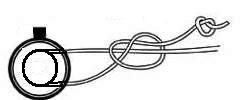

Fishing KnotsThese are what keep you in controlI remember when I started fishing I didn't know any thing about fishing knots, the only knot I knew was how to tie my shoe laces. It didn't take long for me to learn a simple knot tying the hook to the line is not going to work. One of the first times I hooked a fish I was all excited, I had actually hooked a fish. I jumped up and started to reel in my catch, all the time I was trying to think what it was I had hooked. Then suddenly the line went slack, I knew the fish had got away so I sat back down dejected and reeled in the line. When I got the line in I went to put a worm on the hook to try again but there was no hook, just the line all curled up, where is my hook? I ask myself. With the fish shaking its head to get free the knot had come undone and the fish had got away with my hook in its mouth. When I told this to one of the fishermen along the river he told me that an ordinary knot would not work, that I had to use a special knot to fix the hook to the line, he then proceeded to show me how to tie the hook on properly. I soon learned that there are a few special knots in fishing. These all have a purpose but basically there are three areas where we need knots � Securing the line to the reel
Securing the terminal to the line (A terminal can be a hook, a weight, a swivel, a feeder block, a trace, etc..)
Securing line to line.
Securing The Line To The Reel
A knot commonly used to secure the line to the reel is a half blood knot. The one thing you should remember when tying knots in modern day fishing line is to wet the knot before you pull it tight, this stops friction wearing on the line and causing it the fray and break. Another knot commonly used for securing the line to the reel is the Arbor knot. This is a simple knot to tie, it consists on two overhand knots.  Start by passing the line round the spool.
Start by passing the line round the spool.
Then tie an overhand knot with the tag end of the line around the main line. Now tie an overhand knot at the end of the tag line. Moisten the knot and tighten it up. Snip off the excess line.
Securing the terminal To The LineThere are a few knots used to secure terminals to the line. which one you use can change depending on what is being secured, where you are fishing or what type of line you are using.
Some of these are more specialist knots used by fishermen doing a particular technique. These include fishing using braid line, these fishermen prefer to use knots like the uni or the palomar knots. In a lot of the cases there are some other knots commonly used, these include the masheer knot this is probably one of the strongest knots you can tie. Another popular knot for securing the terminal to the line among both sea and course anglers in the locked half blood knot. All of these knots are good at their job, as long as they are tied right. The fishing knots above are used to secure the terminal in a fixed place, but with a float you sometimes need to be able to adjust the position of the float. To allow you to do this use a stop knot. It will let you adjust the depth you are fishing without having to strip everything and re-rig. Securing Line To LineThe fishing knot you use to secure line to line will change largely depending on the lines to be tied. If you are tying a dropper to the main line for fly fishing you will use a different knot than you would if it was a shock leader to the main line in sea fishing. Here we will deal with securing lines for course fishing. This will cover us for securing a hook length, a feeder for legering or two line of similar size and breaking strain. 
Custom Search
Back to Fishing Knots Top Back to Home |






















